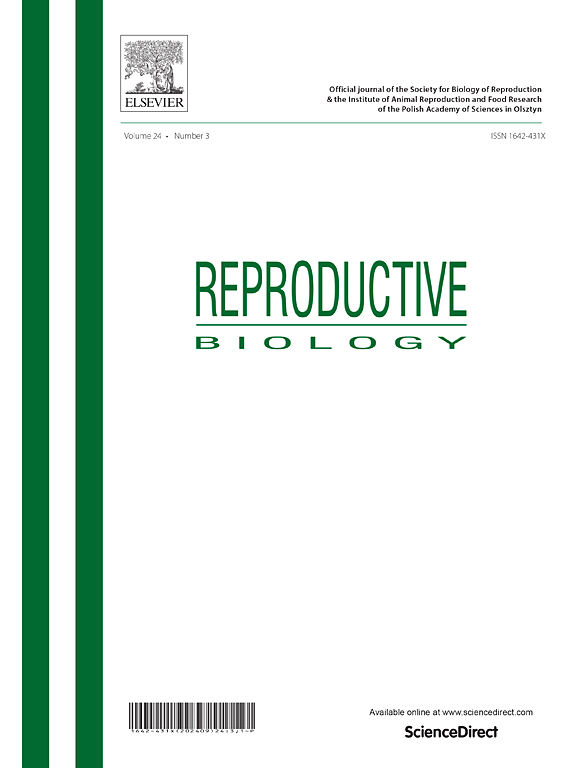单宁酸对谷氨酸钠对睾丸氧化和炎症的保护作用:分子和生化方法
IF 2.5
3区 生物学
Q3 REPRODUCTIVE BIOLOGY
引用次数: 0
摘要
本研究评估了广泛使用的食品添加剂味精(MSG)对大鼠睾丸组织的毒性作用,并研究了天然多酚类化合物单宁酸(TA)对这种毒性的潜在保护作用。为此,将24只大鼠分为4组(n=6)。2 g/kg谷氨酸钠(MSG)治疗21 d。随后给予50 mg/kg单宁酸(TA)处理。在这一时期结束时,收集睾丸组织进行分子和生化分析。分析各组抗氧化酶活性(SOD、CAT、GPx、GST、GR)、氧化应激标志物(GSH、MDA)、炎症标志物(TNF-α、iNOS、COX-2)和DNA损伤指标8-OHdG(8-羟基-2′-脱氧鸟苷)水平。此外,采用qPCR检测抗氧化防御(Sod、Cat、Gpx、Gst、Gr)、炎症(Tnf-α、Il-6、Nf-κB、Cox-2、Inos、Foxo1、Foxo3)和生殖功能相关基因(Dazl、Ddx4、Amh)的表达水平。味精组GSH水平降低,MDA、TNF-α、iNOS和8-OHdG水平显著升高(P<0.01)。SOD、CAT、GST和GR酶活性降低(P<0.01), GPx活性无显著变化。在基因水平上,味精抑制了与抗氧化和生殖细胞功能相关基因的表达,增加了Tnf-α、lL-6、Cox-2和Foxo3的表达(P<0.001)。另一方面,TA单独使用和与味精联合使用均显示出对炎症和氧化应激的改善作用,尽管并非对所有参数都有改善作用。这些数据表明,味精可诱导睾丸组织的氧化应激、炎症、DNA损伤和生殖细胞功能受损。由此得出结论,TA治疗可以抑制这些有害影响,支持细胞防御,并可能有助于保持睾丸功能。本文章由计算机程序翻译,如有差异,请以英文原文为准。
Tannic acid protection against oxidative and inflammatory effects of monosodium glutamate on testis: Molecular and biochemical approach
In this study, the toxic effects of monosodium glutamate (MSG), a widely used food additive, on rat testicular tissue were evaluated and the potential protective role of tannic acid (TA), a natural polyphenolic compound, against this toxicity was investigated. For this purpose, 24 rats were divided into four groups (n=6). They were administered 2 g/kg monosodium glutamate (MSG) for 21 days. Subsequently, they were treated with 50 mg/kg tannic acid (TA). At the end of this period, testicular tissues were collected for molecular and biochemical analyses. Antioxidant enzyme activities (SOD, CAT, GPx, GST, GR), oxidative stress markers (GSH, MDA), inflammatory markers (TNF-α, iNOS, COX-2) and DNA damage indicator 8-OHdG (8-hydroxy-2′-deoxyguanosine) levels were analyzed in the experimental groups. In addition, expression levels of antioxidant defense (Sod, Cat, Gpx, Gst, Gr), inflammation (Tnf-α, Il-6, Nf-κB, Cox-2, Inos, Foxo1, Foxo3) and reproductive function-related genes (Dazl, Ddx4, Amh) were evaluated by qPCR. In the MSG group, a decrease in GSH level and a significant increase in MDA, TNF-α, iNOS and 8-OHdG levels were found (P<0.01). While a decrease was observed in SOD, CAT, GST and GR enzyme activities (P<0.01), no significant change was found in GPx activity. At the gene level, MSG administration suppressed the expression of genes related to antioxidant and germ cell functions and increased the expression of Tnf-α, lL-6, Cox-2 and Foxo3 (P<0.001). On the other hand, TA, both alone and in combination with MSG, demonstrated ameliorative effects on inflammation and oxidative stress, although not on all parameters. The data suggest that MSG induces oxidative stress, inflammation, DNA damage, and impaired germ cell function in testicular tissue. It was concluded that TA treatment suppresses these harmful effects, supports cellular defenses, and may help preserve testicular function.
求助全文
通过发布文献求助,成功后即可免费获取论文全文。
去求助
来源期刊

Reproductive biology
生物-生殖生物学
CiteScore
3.90
自引率
0.00%
发文量
95
审稿时长
29 days
期刊介绍:
An official journal of the Society for Biology of Reproduction and the Institute of Animal Reproduction and Food Research of Polish Academy of Sciences in Olsztyn, Poland.
Reproductive Biology is an international, peer-reviewed journal covering all aspects of reproduction in vertebrates. The journal invites original research papers, short communications, review articles and commentaries dealing with reproductive physiology, endocrinology, immunology, molecular and cellular biology, receptor studies, animal breeding as well as andrology, embryology, infertility, assisted reproduction and contraception. Papers from both basic and clinical research will be considered.
 求助内容:
求助内容: 应助结果提醒方式:
应助结果提醒方式:


